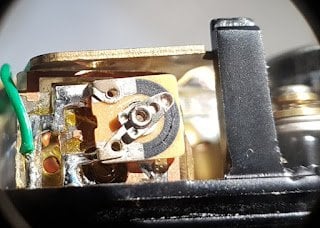wrs1145
A native Texan looking for the light.
What modern battery replacement does this camera take for proper use? What battery replacement holder does it take?
Thanks,
Bill
Thanks,
Bill
Last edited:
wrs1145
A native Texan looking for the light.
Nobody can give me any advice?
KoNickon
Nick Merritt
This camera takes a 625 battery. The mercury 625s are no longer available but you can find alkaline 625As pretty easily. The voltage is not the same (the 625A will underexpose by one stop) but you can compensate by setting the film speed one stop lower -- with 400 speed film, set the film speed at 200, for example.
TenEleven
Well-known
Kanto Camera also sells an adapter which will adjust the voltage of these batteries if you put in a SR43 I believe it is.
SALE Battery Adapter (English site)
SALE Battery Adapter (English site)
Barry Kirsten
Established
Commercially available adapters are expensive IMO. You can often do your own modification (subject to camera complexity) very easily, allowing a SR44 silver oxide cell to be used. I found this article helpful: https://www.abcde.de/fotobatterien/batt-adapt-us.pdf when I did my OM-1.
Dayrell bishop
Well-known
Rayovac hearing aid batteries I believe are the same as Wein cells, the ones in the blue pack 675 I think . They are zink air batteries ,you would have to make a small spacer for the battery to go inside {plastic plumbing pipe} they are verry cheap.
Nitroplait
Well-known
Using cheap standard PR44/675 hearing aid cells from your pharmacy or Amazon adapted with either a dumb brass adapter (picture below) or a DIY hack is by far the cheapest and easiest way to achieve the 1.35V required - if you can live with the short life of zinc-air batteries (4-8 months) and don't leave them in the camera if left unused for a long time.
Don't waste your money on Wein cells - they are the exact same as above.
Converters like the Kanto MR-9 shown below are more expensive but will give you normal battery life. The SR43/386 batteries are a little harder to find than 675 zinc-air in my experience.
I am happily using both of the above solutions in my vintage cameras and meters.
I don't recommend using the Alkaline 625 substitutes for several reasons:

Don't waste your money on Wein cells - they are the exact same as above.
Converters like the Kanto MR-9 shown below are more expensive but will give you normal battery life. The SR43/386 batteries are a little harder to find than 675 zinc-air in my experience.
I am happily using both of the above solutions in my vintage cameras and meters.
I don't recommend using the Alkaline 625 substitutes for several reasons:
- Alkaline tend to leak and should never be used in valuable equipment - I check used camera equipment for a camera shop and get nightmares over all the fine cameras I have seen ruined by alkaline batteries.
- Alkaline has an unfavourable discharge profile - the reading will often change throughout the battery life.
- When fed a higher voltage, lightmeters may not act in a linear manner. i.e. you may not get a correct reading by merely adjusting the exposure compensation dial or ISO dial a fixed value.

p.giannakis
Pan Giannakis
Correct. Most work ok by adding +1EV exposure compensation but in darker or brighter situations this needs to be adjusted further more.When fed a higher voltage, lightmeters may not act in a linear manner. i.e. you may not get a correct reading by merely adjusting the exposure compensation dial or ISO dial a fixed value.
Also, some lightmeters work the other way around - I.e decrease the amount of voltage, let's say by -1.5EV.
If you are lucky with the Minolta, there might be a potentiometer somewhere that adjusts the meter like the one pictured below (that is from my Vivitar).

Share:
